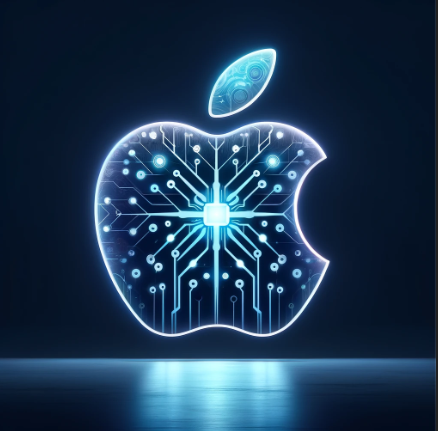A is for Apple Intelligence (AI) Or: Here Comes The aiPhone
It’s fascinating to wonder where Apple would be today, and what it would be doing in AI, if Steve Jobs were still at the helm.

This is Part 2 of a series of articles breaking down and ranking the AI strategies of the Magnificant 7.

Computers “can amplify an inherent intellectual ability that man has, and really take care of a lot of drudgery, to free people to do much more creative work.” — Steve Jobs in 1981.
Apple is next up in our series of reviewing the AI strategies of the Mag 7, and it’s up about 6% today as of this writing after the company reported a much better-than-expected first quarter last night. China weakness had been all the talk since the beginning of the year and Apple showed us last night that the fears were largely overblown when the company reported both slight top and bottom line beats and raised its guidance for the June quarter.
Apple’s AI strategy can currently be summed up with a big question mark (?) because we do not yet know the specifics of the company’s plans. Unlike the rest of the Sexy 6, Apple only operates a few of its own data centers and it has not been spending billions of dollars buying the latest NVIDIA chips to keep up with the competition.
In this article, we will examine Apple’s history in AI and discuss its AI potential given what we already know about the company. Apple plans to reveal much more about its AI strategy at its annual Worldwide Developers Conference (WWDC) on June 10th.
Apple’s history in AI
Despite not knowing what AI cards Apple is holding in its hand at the moment, the company actually has a lot of history in AI and machine learning, although it hasn’t always been good. Siri has been butt-calling people, reporting “what it found on the internet,” otherwise misinterpreting us for thirteen years now! It’s absolutely flabbergasting that Apple has not improved Siri more than it has at this point. Perhaps it’s a testament to how much the quality of AI is determined by the power of the chips that it runs on. Other than detecting your voice saying “Hey Siri,” almost all of Siri’s functionality is empowered by the cloud. Apple relies on AWS, Google, and Microsoft Azure to run Siri, iCloud, Apple Music, etc. If Apple had built its own data center chips like it has with SoCs that run the devices, there is a chance that Siri could have been improved much more than it has over the last thirteen years.
Besides Siri, Apple has experience using AI and machine learning in Apple Photos, Maps, Music, and many other parts of the Apple ecosystem. Further, Apple’s facial recognition feature uses deep learning to analyze facial structures. Apple has also modified its custom silicon products for its devices to incorporate neural engines that make AI and machine learning workloads run much faster. Apple’s latest and greatest chip, the M3 (introduced in October 2023), runs AI workloads 60% faster than the M1 which was introduced in November 2020.
In sum, Apple’s history with AI is rather lackluster in our opinion. Since the launch of Siri in 2011, Apple has spent a cumulative $162 billion on research & development. Obviously, all of this money did not go towards AI research, but we would still say that this has produced a rather poor ROI given the rather unimpressive improvements in Apple’s AI products since that initial launch. That said, we have continued to ride Apple as it has gone up 1,535% since the day they launched Siri, so who are we to judge?
What Will Apple Intelligence (AI) Look Like?
We see at least three key strengths for Apple Intelligence (AI): (1) data; (2) unrivaled form factors; and (3) Apple’s capex light model.
If you are an iPhone or Mac user, Apple arguably knows more about you than any other company on the planet. This is incredibly powerful and valuable data for Apple. This data can be used to dramatically improve the quality and utility of the AI. Siri or another chatbot built into the Apple devices will be much, much more useful if it is trained on data from the actual user. However, using this data to train an AI or otherwise directly attempt to monetize it would run contrary to one of Apple’s core values: privacy. Apple reportedly collects only minimal data about its users. Its Maps data, for example, does not associate the actual user with the location, rather, it uses random identifiers that are regularly reset to avoid creating a profile of movements and searches. Further, Apple allows users to ask each app not to track them which has significantly changed how companies like Meta and Google monetize the iPhone users on their platforms.
So will Apple use its access to a potential treasure trove of user data to its advantage in AI? The answer is yes, with a twist. Apple is focusing all of its efforts on running AI on the device, or at the “edge” as it is known. Apple’s privacy policy simply limits the extraction and centralization of user data, but Apple has no qualms about using user data to improve the functionality of its devices, as long as the data never leaves the device. In order to achieve this goal, Apple has to make extremely powerful and efficient chips that are able to run AI on the device, rather than in the cloud.
We think there is a high likelihood that Apple’s existing chips are powerful enough to run a small LLM on the device. But the real question is if they can come up with a combination of software and hardware that will allow for AI training on the device, not just inference. Apple could also utilize federated learning to both train AI models and protect user privacy. Google first introduced the idea of federated learning, and here is a summary of how it works from IBM: “Each party downloads the model from a datacenter in the cloud, usually a pre-trained foundation model. They train it on their private data, then summarize and encrypt the model’s new configuration. The model updates are sent back to the cloud, decrypted, averaged, and integrated into the centralized model. Iteration after iteration, the collaborative training continues until the model is fully trained.”

We think Apple will use some combination of on-device AI and federated learning to train its AI models so that it can continue to say it is protecting user privacy. Ultimately, we all know that our data is being used by Apple and others to monetize products/services and at some point its foolish to think you can be part of the Apple ecosystem and not have them use your data to try and further monetize you as a user.
Next, we think Apple may have the best form factors for making AI practical and useful in our everyday lives. Obviously, the iPhone is probably the single best piece of hardware ever invented and it has no doubt changed the world and humanity forever. Most of us have our entire lives on the iPhone. The apps we use every day are critical how we live and interact with each other. And all of it goes through Apple.
We think Apple could build AI into iOS so that it will act increasingly like an agent, and less like a chatbot. Call it the “aiPhone.” ChatGPT, Google Gemini, Anthropic Claude, and all of the dozen other AIs right now simply operate in a question-and-answer format. They do not currently have the capability to actually do anything for you. But if Apple can figure out a way to incorporate AI into the OS so that it can not only respond like a human, but act like a human, then that will take AI to the next level. Let’s think about how this might work. Apple could potentially build out Siri (or a new voice agent) that could go from telling you the weather will be this weekend, to actually booking your tee time when the weather is predicted to be the best. Instead of asking Siri how far it is from your office to your favorite restaurant, it will be able to book the Uber ride for you to get there. Instead of telling you what your schedule looks like for next Tuesday, it will be able to automatically set up meetings using Facetime or another video conferencing software and send invitations to all of the participants after reading your emails.
Obviously, the potential use cases for an AI that is built into the operating system of the phone, Mac, Vision Pro, etc. that has the capability to interact with your apps and do things for you will be tremendous. This AI won’t likely be a standalone profit center for Apple, but it will further drive iPhone adoption, increase ASPs, and pull forward iPhone upgrade cycles. At the end of the day, if Apple AI dramatically increases the productivity of humans using Apple products, then a lot of that value will flow through to Apple in various forms (including through services, which we haven’t even mentioned).
Finally, the last big advantage for Apple in AI is that it will be a capex-light strategy, unlike all of the other Sexy 6. As mentioned in the first article, the Sexy 6 will be spending over $200 billion this year on building AI data centers. We think Apple is actually going to be a beneficiary of this spending, because it is going to get access to the best compute available to use in its products, without having to incur the tens of billions of additional capex. Apple already works with all of the major cloud service providers (CSPs) — Google, Microsoft, and Amazon — and will be able to leverage their advanced compute to build its AI. And as mentioned, we think most of the AI training and inference is going to be done on the device anyways, so it’s not like Apple’s cloud expenses are going to go through the roof. However, all of this depends on Apple building sufficiently powerful and power-efficient chips for the iPhone, Macbooks, Vision Pro, etc. that can train and run the AI without killing the battery in an hour or so.
In conclusion, we think Apple AI will be very useful and exciting once it’s here. It may not be a massive growth driver for Apple like it will be for some of the others in the Sexy 6, but we do think it will be a great addition to the already great Apple ecosystem and will continue to entrench Apple as the world’s leader in hardware. We think it could be a good driver of the iPhone refresh cycles for the next couple of years as it starts to roll out and, given Apple’s massive installed base, it will be fairly easy for Apple to monetize in the form of new hardware sales. Moreover, Apple could surprise us all with some AI service that we haven’t thought of before, like a premium LLM that costs $20/month or something, that would further driver monetization. However, we think it is more likely that the AI service is simply built into every Apple product going forward, and Apple continues to make money as it always has, selling iPhones, Macs, iPads, etc. and making some money on the backend with services like Apple Music, TV, etc.
We give Apple a 7.7 out of 10, which puts it in 5th place out of the Mag 7.




